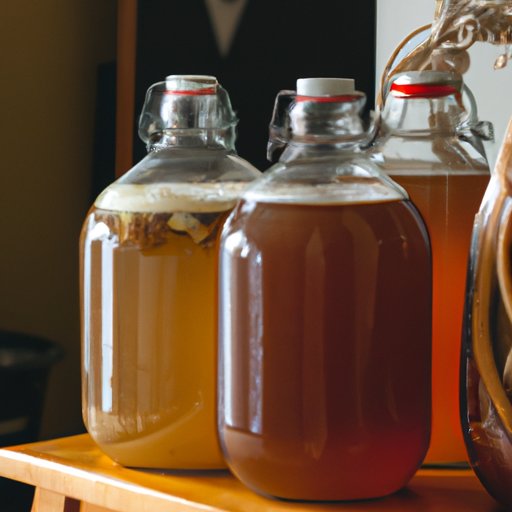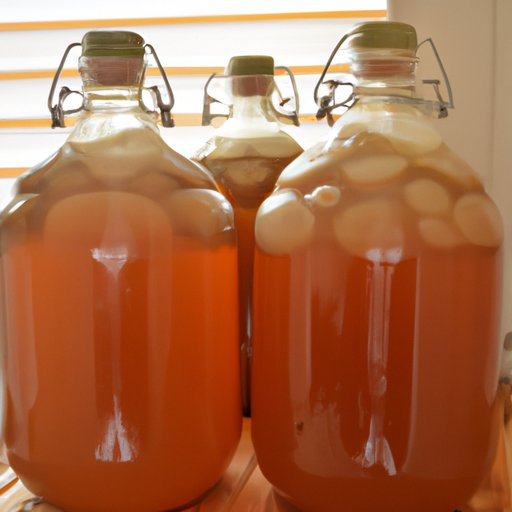Introduction
Kombucha culture has been around for centuries and is gaining in popularity as a health-promoting beverage. The bubbly, fermented tea is made from a combination of yeast, bacteria, and sweetened tea that is left to ferment for several days. While some people may not be familiar with this drink, it has many beneficial properties that make it worth exploring. In this article, we will delve into what kombucha culture is and explore its origins, health benefits, and tips on making your own kombucha culture at home.
Comprehensive Guide to Kombucha Culture
Kombucha culture is a probiotic-rich drink that is made by combining yeast, bacteria, and sweetened tea that is left to ferment for several days. It is believed to have originated in East Asia as early as 220 BC and has since spread across the globe. It is now widely consumed in countries such as Japan, China, Germany, and the United States.
Exploring the Origins and History of Kombucha Culture
The exact origin of kombucha culture is unknown, but it is believed to have originated in East Asia as early as 220 BC. It was used as a medicinal elixir by the Chinese, Japanese, and Koreans, who prized its health-promoting properties. From there, it spread to other parts of the world, such as Russia, Germany, and the United States.
Understanding the Science Behind Kombucha Culture
Kombucha culture is made by combining yeast, bacteria, and sweetened tea that is left to ferment for several days. During this process, the yeast and bacteria convert the sugar in the tea into acetic acid, which gives kombucha its tangy taste. This process also creates beneficial bacteria and yeast, which are known as probiotics. Probiotics are beneficial bacteria that help promote digestive health and boost the immune system.
Benefits of Kombucha Culture
Kombucha culture has many potential health benefits. Here are some of the most notable ones:
Detoxifying Effects
Kombucha contains antioxidants, which can help protect cells from damage caused by free radicals. Additionally, kombucha is rich in enzymes, which can help the body break down and eliminate toxins more efficiently. This can lead to improved overall health and wellbeing.
Health Benefits
Kombucha is rich in probiotics, which are beneficial bacteria that help promote digestive health and boost the immune system. Additionally, kombucha is high in B vitamins, which can help reduce stress and improve mood. Finally, kombucha is thought to have anti-inflammatory properties, which can help reduce inflammation in the body.
Versatility in Drinks and Foods
Kombucha can be used in a variety of drinks and foods. It can be enjoyed as a refreshing beverage on its own or mixed with other ingredients to create unique flavor combinations. Additionally, kombucha can be used in recipes such as dressings, marinades, and even desserts.

Making Your Own Kombucha Culture at Home
While you can buy kombucha from the store, it is easy and fun to make your own kombucha culture at home. Here is a step-by-step guide on how to make kombucha culture at home:
Gather Supplies
To make kombucha, you will need black tea, white sugar, a large glass jar, cheesecloth, rubber bands, and a SCOBY (Symbiotic Colony Of Bacteria and Yeast). You can purchase a SCOBY online or make your own.
Prepare Kombucha Tea
Place 3-4 tablespoons of loose-leaf black tea in 1 quart of boiling water and steep for 10 minutes. Once the tea has cooled, add ½ cup of white sugar and stir until dissolved. Allow the tea to cool completely before moving on to the next step.
Create the SCOBY
Place the SCOBY in the prepared tea and cover with a piece of cheesecloth secured with a rubber band. This will allow the SCOBY to breathe while keeping out any contaminants.
Ferment the Kombucha
Place the jar in a warm, dark place and let it sit for 7-10 days. During this time, the SCOBY will feed on the sugar in the tea and produce kombucha.
Bottle and Store
Once the kombucha has fermented, it is ready to be bottled and stored. Gently pour the kombucha into bottles, leaving about an inch of headspace. Secure the lids tightly and store in the refrigerator for up to two weeks.
Troubleshooting
If your kombucha does not taste right or has an off odor, discard it and start over. Additionally, if the SCOBY starts to grow mold, discard it and start again.
Conclusion
Kombucha culture is a fermented drink that has many potential health benefits. It is rich in probiotics, antioxidants, and B vitamins, which can help boost the immune system and improve overall health and wellbeing. Additionally, kombucha is versatile and can be enjoyed in a variety of drinks and foods. If you are interested in trying kombucha, you can make your own at home with a few simple steps. With a little patience and practice, you can easily make your own kombucha culture at home.
Summary of Benefits of Kombucha Culture
Kombucha culture is a probiotic-rich drink that has many potential health benefits. It is rich in antioxidants, probiotics, and B vitamins, which can help boost the immune system and improve overall health and wellbeing. Additionally, kombucha is versatile and can be enjoyed in a variety of drinks and foods.
Tips for Making Your Own Kombucha Culture at Home
Making kombucha culture at home is easy and fun. Gather the necessary supplies, prepare the kombucha tea, create the SCOBY, ferment the kombucha, bottle and store, and troubleshoot any issues that arise. With a little patience and practice, you can easily make your own kombucha culture at home.
(Note: Is this article not meeting your expectations? Do you have knowledge or insights to share? Unlock new opportunities and expand your reach by joining our authors team. Click Registration to join us and share your expertise with our readers.)
